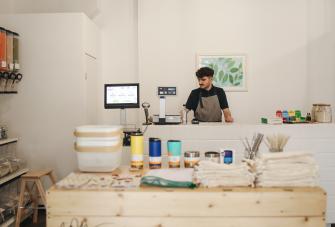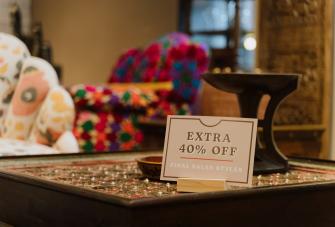What is electronic retailing?
Did you know that last year, 20% of all retail sales happened online? That’s one in five purchases. One in five people choosing their phone or laptop over walking into a store.
It's clear that etailing, also known as electronic retailing, has a huge part to play in the future of the retail industry.
While we're not saying that brick-and-mortar stores are dead and gone, and that the future is online sales alone, we do think that it's important to really prepare.
Because the truth is, people still love the in-person shopping experience. However, the future isn’t just physical stores alone. It's online too. It’s both.
And that combination, that balance, is what’s shaping the next chapter of retail.
So today we're going to give you the 411 on all things e-tailing. You’ll understand how it works in practice, the different types that exist, the benefits (and challenges), and even explore some real-world examples so you know what it looks like in practice.
Definition & key concepts
First up, let's get really clear on what e-tailing is. After all, you can't implement something at your business if you don't fully understand it, right?
Etail meaning
E-tailing means selling products and services online. Now, this could be through websites, apps on their mobile devices, or even social media, basically any online channel.
For instance, say you run a small boutique that sells gorgeous retail products. You already have a brick and mortar store, the shop you sell your designs in.
But to get involved in etailing you'd set up online platforms (like a digital marketplace or website storefront) too. That way, customers don’t have to walk through your door to shop, they can do it anytime, from anywhere.
Difference between etail and broader e-commerce
E-tail is just selling things online, like your favorite store’s website or app. E-commerce is bigger. It’s any online business activity, including buying, selling, marketing, and even payments.
Types of e-tailing: B2C vs. B2B
There are two main types: B2C and B2B.
- Business to consumer (B2C): This is what most people think of when they hear “online shopping.” It’s businesses selling directly to individual customers. Think Amazon, your favorite boutique’s online store, or even apps like Etsy.
- Business to business (B2B): This is when businesses sell to other businesses. For example, a company might sell bulk office supplies to other companies online. These transactions are usually larger, more complex, and often involve contracts, recurring orders, or special pricing.
How e-tailing works
So, how does e-tailing actually work? Let’s break it down step by step.
- Step 1. Setting up shop online: E-tailers create websites or apps to display their products.
- Step 2. Adding products: Sellers upload photos, write descriptions, set prices, and add stock details. Good images and clear descriptions are key here because customers want to know exactly what they’re buying, and reviews often help them make that final decision.
- Step 3. Managing stock: E-tailers keep track of inventory so they don’t sell out unexpectedly. Tools like retail POS systems are a great way to do this. It can help online retailers get real-time information about their inventory and generate reports that show them what's selling well and what isn't.
- Step 4. Shopping cart: Customers browse on search engines and other online shopping platforms, pick out items, and drop them into a virtual shopping cart.
- Step 5. Upselling: Just like in a store, you can suggest related or higher-value products right in the shopping cart or at checkout. It’s known as retail upselling.
- Step 6. Checkout: When they’re ready, buyers add their shipping info and payment information. Platforms often have built-in payment gateways and payment processing like Epos Now Payments.
- Step 7. Secure payment options: Security matters. In 2023 alone, nearly 3% of ecommerce revenue was lost to payment fraud. That’s why platforms like Epos Now provide fraud protection and support different payment methods to keep transactions safe.
- Step 8. Order fulfillment: Once payment clears, the order gets packed and shipped.
- Step 9. Marketing: To get customers in the door (or in this case, on the site) e-tailers use digital marketing, SEO, social ads, and email marketing to attract traffic and boost sales.
- Step 10. Customer support: Retailers stay connected with shoppers through email, chat, or phone. Many platforms also give merchants tools like live chat and FAQ systems so they can respond quickly and keep customers happy.
- Step 11. Data and insights: E-tailers track sales data and customer behavior. Data analytics tools help them spot trends and make smarter decisions for the future.
Benefits of Etail
Here's why electronic retailing is essential:
- Cheaper to run than a physical store: You don’t need a big storefront, expensive rent, or tons of staff. Setting up online is way lighter on the wallet.
- Shop anytime, anywhere: Your store never closes. Customers can browse and buy at 2 am from halfway across the world. This means you’re more likely to meet those retail KPIs you have.
- Smarter marketing and happier customers: With all the data you get, you can show people what they actually want, send them personalized deals, and keep them coming back for more.
Challenges & considerations
There are, however, some things you'll need to think about... Some challenges you could face along the way.
- Can’t touch it: Customers can’t see or feel the product before buying, so you’ve got to make sure your photos, descriptions, and quality are spot on for your target audience.
- Safety first: Online payments come with risks. There's fraud, scams, trust issues. You need strong security in your business model to keep customers confident and the customer experience strong.
- Getting it to them: Shipping delays, tricky returns, and gaps in customer service can make or break the experience. You’ve got to stay on top of logistics and support.
We have a full guide of problems and solutions in retail you can read to learn how to solve these issues.
Etail vs. brick-and-mortar & omnichannel integration
Many brick-and-mortar shops now have websites, apps, and social media shops. They’re not replacing the store. No, they’re adding a new way for customers to buy. This helps them reach more people and stay competitive in a world where one in five purchases is already online.
Omnichannel strategies
Shopping today is no longer just online or in-store but a mix of both. More than half of Americans (54%) shop online more now than in 2020.
Still, 36% prefer going into stores, and 51% overall like online shopping best.
This has led to a brilliant trend called hybrid shopping, which just means combining channels. Customers might browse online, buy online, and pick up in-store. That's just one example.
The same study tried to predict customer preferences by looking into customer data and found:
- Curbside pickup: 24% of shoppers choose this as their second option
- In-store pickup: 21%
- In-store shopping: 20%
If there's one thing you can take away from this, it's this: Offering multiple options is key. People want flexibility, and brands that blend online and offline. They want an omnichannel experience.
Real-world examples & success stories
Let’s look at some companies that are killing it with e-tailing.
First up, there's Amazon and Alibaba, both with a huge market share in this world. These giants show how powerful online retail can be. With millions of products, global reach, and fast shipping, they make shopping easy for customers and profitable for sellers.
Subscription models, like Netflix, are another example of etailing. People pay a recurring fee and get products or services delivered digitally on autopilot. It’s a simple idea, but it works.
Sectors like beauty products, corporate finance, and durable goods are other industries that really work here. From skincare brands shipping globally to consumers, to electronics companies selling to other businesses through their distribution networks, these industries are proving that online sales can be as big (or bigger) than traditional stores.
Get Online (and Selling!) with Epos Now Online
Launch a sleek online store, sync your products, and start taking orders - all in one place.
No coding. No fuss. Just fast, connected commerce.
Best practices
Want your e-tailing game to really work? There are a few key things to focus on:
- Make your site mobile-first, easy to navigate, and personalized. We call this UX optimization.
- Great photos and videos make products feel real. Customers need to see what they’re buying because they're not going into a store.
- Offer multiple payment options and integrate secure payment systems. BNPL, credit card, and pay by link are just a few options.
- Keep on track of inventory management with a retail POS system.
- Options like curbside pickup, BOPIS, or local delivery make shopping convenient.
- Stay connected, promote new products, and encourage repeat purchases without spamming.
- Offer quick responses to customer inquiries through chat, email, or phone build trust and loyalty.
- Protect customer info and use analytics to personalize recommendations, offers, marketing and email campaigns.
Summary & strategic takeaway
That's it from us. You now know everything there is to know about etailing - what it is, how it works, the types, the benefits, the challenges, and even some best practices.
Now, it's time to hear how Epos Now can help:
- POS system: Manage sales, stock, and staff in one place.
- Payment processing: Fast, secure, and simple for you and your customers.
- Epos Now Online: Set up a seamless online storefront to reach customers anytime, anywhere.
Ready to grow your business? Contact us today and start your e-tailing journey.
FAQs
- What does “E-tailing” refer to?
-
It’s just a term for selling stuff online. Your shop, but on the internet.
- How is E-tail different from general e-commerce?
-
E-tail is all about the retail side (selling products online) while e-commerce covers everything online, including services and business tools.
- What are the main types of E-tailing (B2C vs. B2B)?
-
B2C is selling straight to customers; B2B is selling to other businesses. Same idea, different audience.
- What advantages do businesses gain from adopting etail?
-
Lower costs, 24/7 global reach, smarter marketing, and happy, loyal customers.




